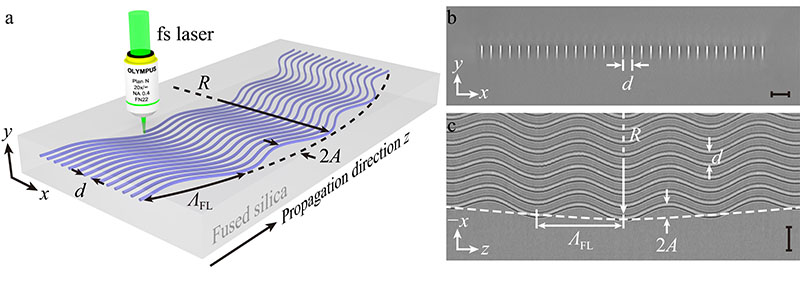| May 10, 2024 |
Visual observation of photonic Floquet-Bloch oscillations
(Nanowerk News) Recent studies on Bloch oscillations (BOs) in periodically driven quantum systems, also known as "Floquet systems," have attracted considerable interest due to their unique characteristics, which are distinctly different from those in static systems.
|
|
Researchers have specifically focused on two variants of Bloch-like oscillations: quasi-Bloch oscillations (QBOs) and super-Bloch oscillations (SBOs). Despite these advances, the inherent connections between these oscillations in Floquet systems are still not well-understood, and a comprehensive theory of BOs in these systems has yet to be developed. Moreover, the direct visual observation of BOs in Floquet systems remains a largely unexplored area in experimental studies.
|
|
In a recent publication in Light: Science & Applications ("Visual observation of photonic Floquet–Bloch oscillations"), a team led by Professor Xuewen Shu from Huazhong University of Science and Technology, China, and Professor Xiankai Sun from The Chinese University of Hong Kong, have expanded the concept of Bloch oscillations to photonic Floquet lattices.
|
 |
| a Schematic of a one-dimensional lattice composed of evanescently coupled waveguides with a combined bending trajectory, i.e., a superposition of circular bending trajectory and periodic bending trajectory. b Cross-sectional optical microscope image of the fabricated sample. Scale bar, 30 µm. c Top-view optical microscope image of the fabricated sample with a harmonic modulation. Scale bar, 30 µm
|
|
This development has introduced what are termed "photonic Floquet–Bloch oscillations (FBOs)," which are essentially rescaled photonic Bloch oscillations with an extended period that is the least common multiple of the modulation period and the Bloch oscillation period. Photonic FBOs occur under any arbitrary Floquet modulation when the ratio of the Floquet modulation period to the Bloch oscillation period is non-integer. This new framework not only unifies the conventional QBOs and SBOs but also treats them as specific instances of FBOs.
|
|
Using waveguide fluorescence microscopy, the team has directly visualized the dynamic breathing and oscillatory motions of photonic FBOs in femtosecond-laser-written waveguide arrays. They have experimentally investigated two novel properties of photonic FBOs: the fractal spectrum and fractional Floquet tunneling. These investigations suggest that photonic FBOs represent a distinct transport phenomenon, which is also a generalization of existing BOs in Floquet systems.
|
|
To facilitate the visualization of Bloch oscillations in a photonic Floquet lattice, the researchers designed an array of circular bending optical waveguides with periodic modulation. The spatial evolution of low-power light within this lattice mimics the temporal evolution of non-interacting electrons in a periodic potential subjected to an electric field.
|
|
In this setup, the propagation coordinate z acts as "time," while the curvature of the waveguides simulates an effective electric field force on the light waves. The circular bending trajectory provides a constant electric field force necessary for BOs, and the periodic bending trajectory introduces a periodic electric field force, serving as the Floquet modulation. This design supports an experimental realization of Bloch oscillations in a photonic Floquet lattice.
|
|
During the experiments, visible-light excitation by a He-Ne laser (633 nm) and the capture of fluorescent signals (650 nm) emitted from the waveguides were implemented. The top-view fluorescent signals record detailed continuum evolution, enabling precise quantitative analysis. The visual observations and corresponding quantitative analyses of BOs in these photonic Floquet lattices showed excellent agreement with simulation results.
|
|
Photonic Floquet–Bloch oscillations are a coherent phenomenon that can be readily adapted to various physical systems, including ultracold atoms, synthetic frequency lattices, and quantum walks. The ability to visually observe photonic FBOs is crucial for understanding the underlying transport mechanism and has a significant impact on both fundamental research and practical applications.
|
|
In terms of fundamental research, the straightforward visualization of this phenomenon and the high degree of control over the fabricated structure allow further exploration of fundamental phenomena involving FBOs, such as the interactions between FBOs and binary lattices, non-Hermitian lattices, and optical nonlinearity.
|
|
For practical applications, the demonstrated manipulation of optical waves can be applied in various wave systems, potentially offering new insights into applications such as wave manipulation, signal processing, high-efficiency frequency conversion, and precision measurement.
|

